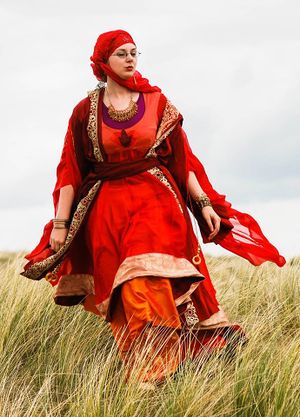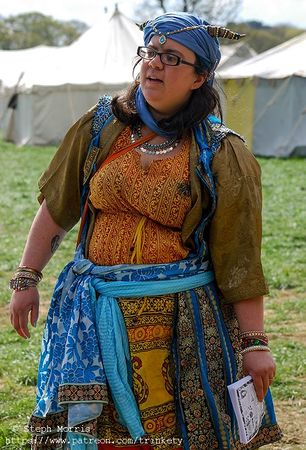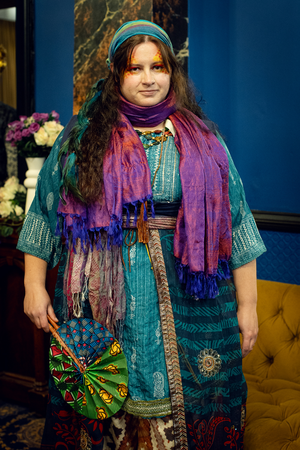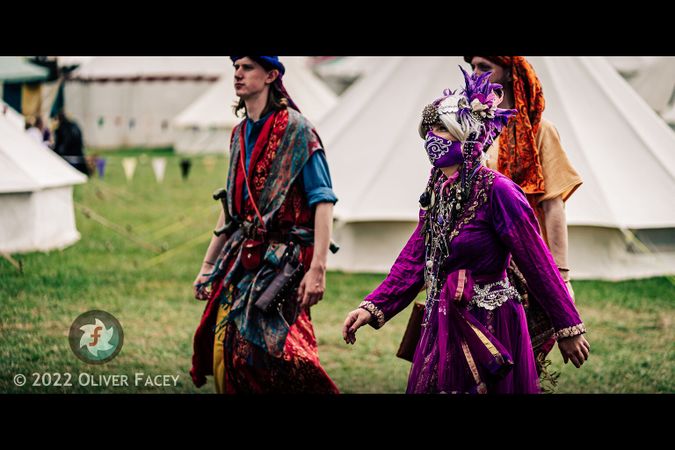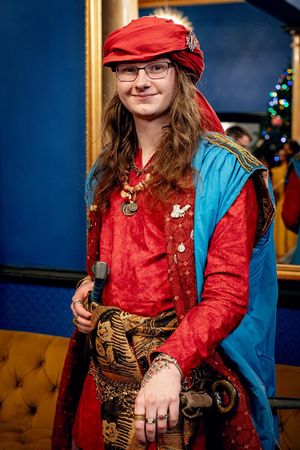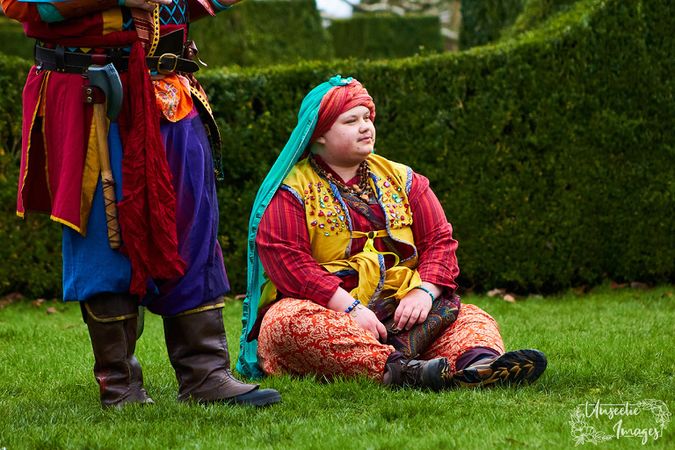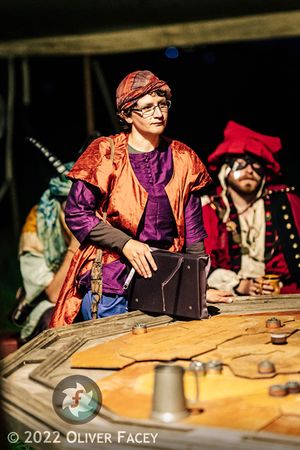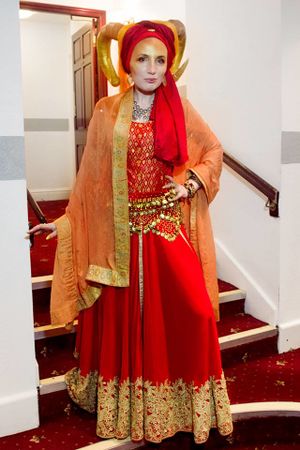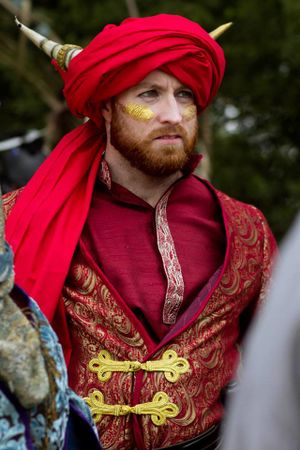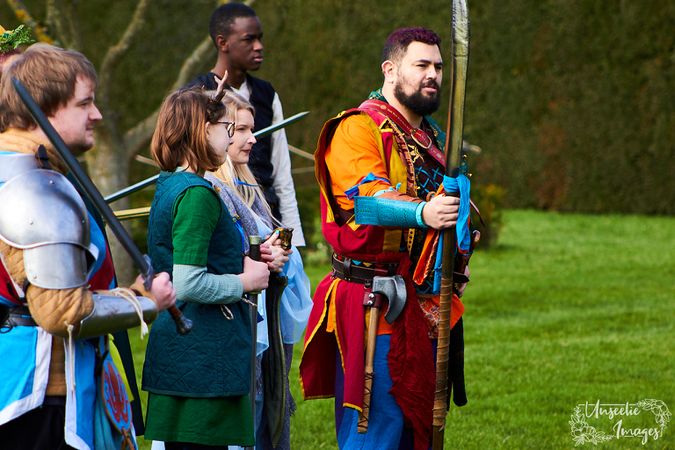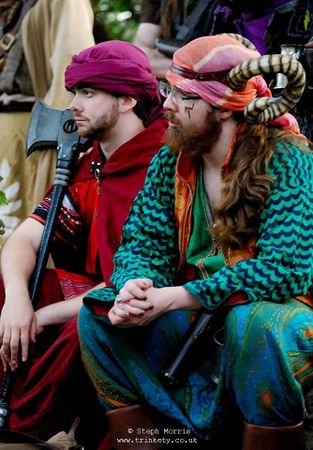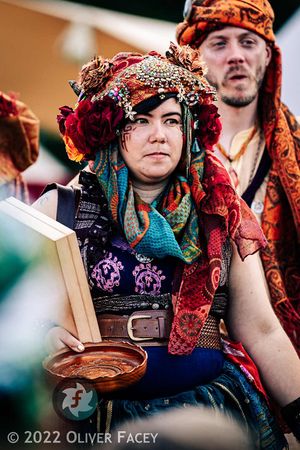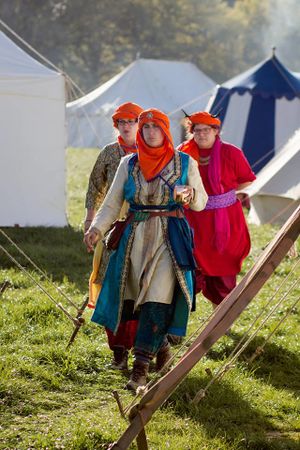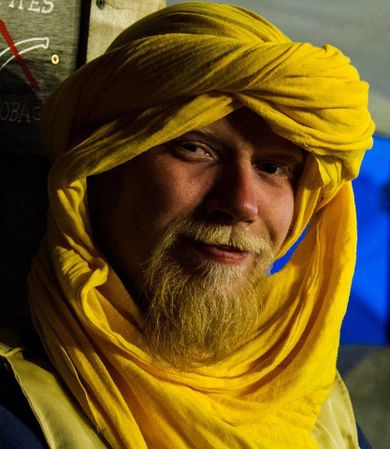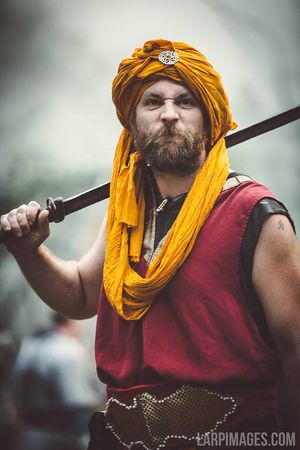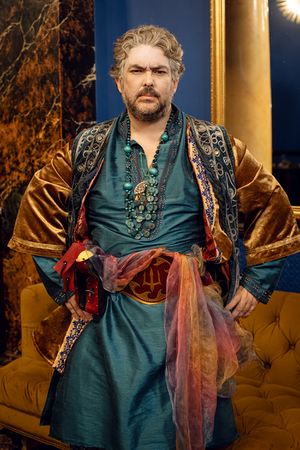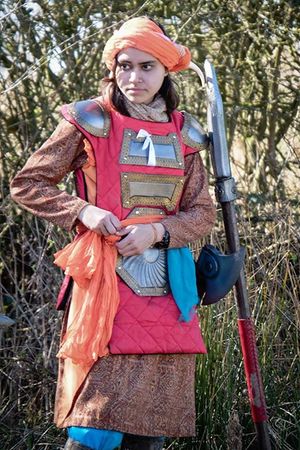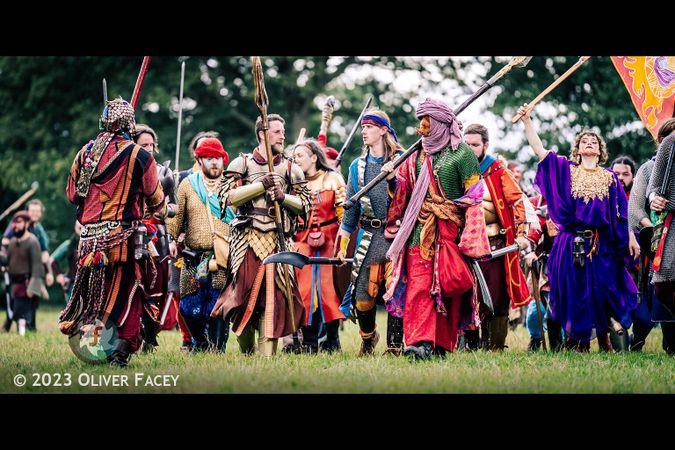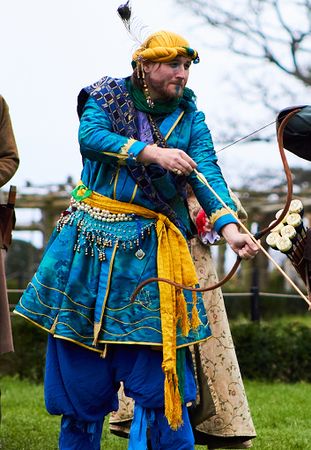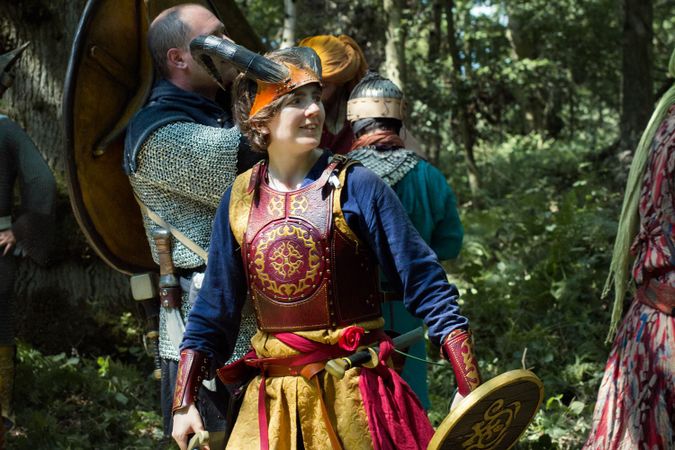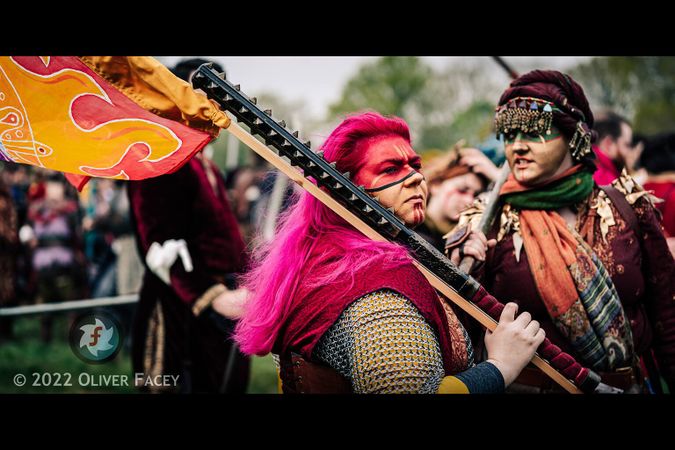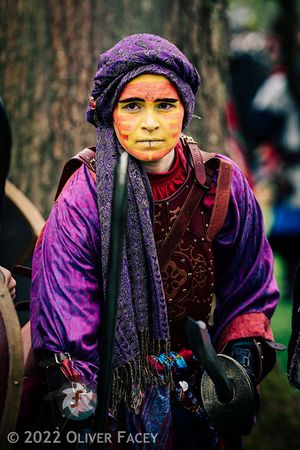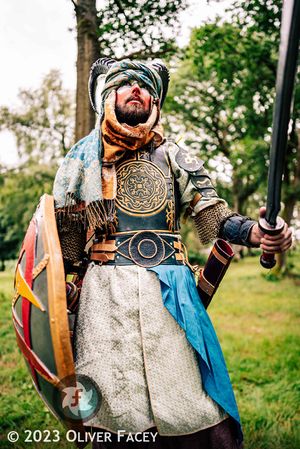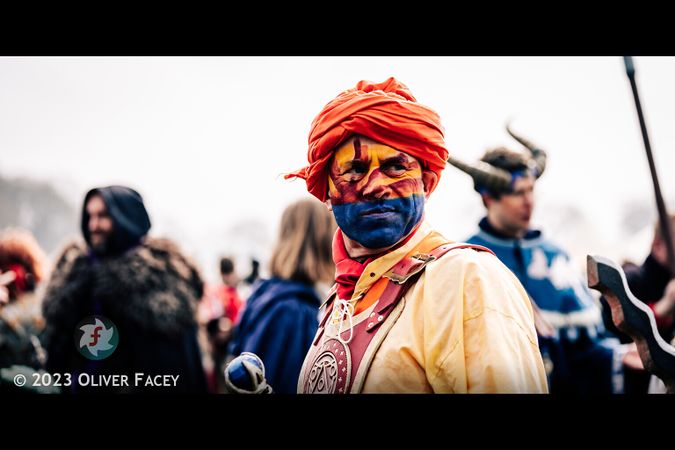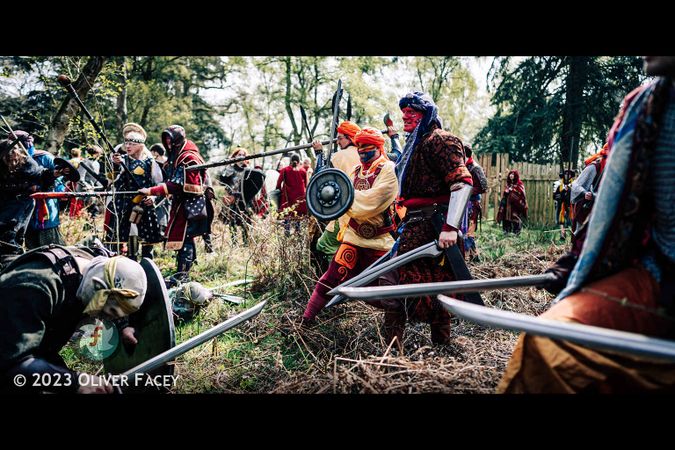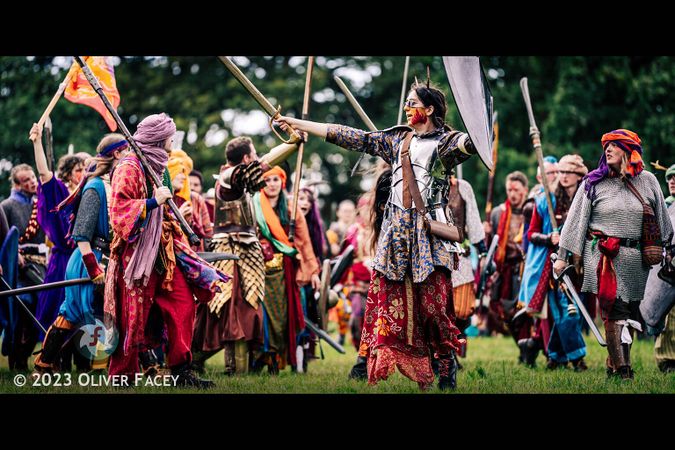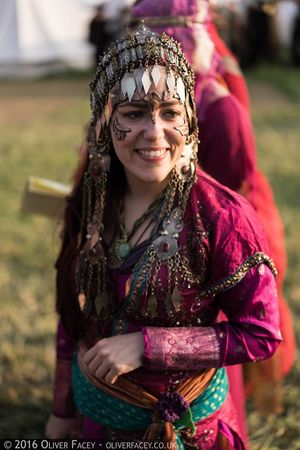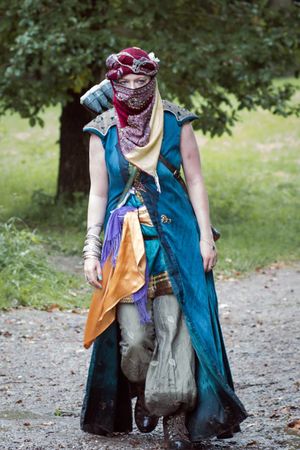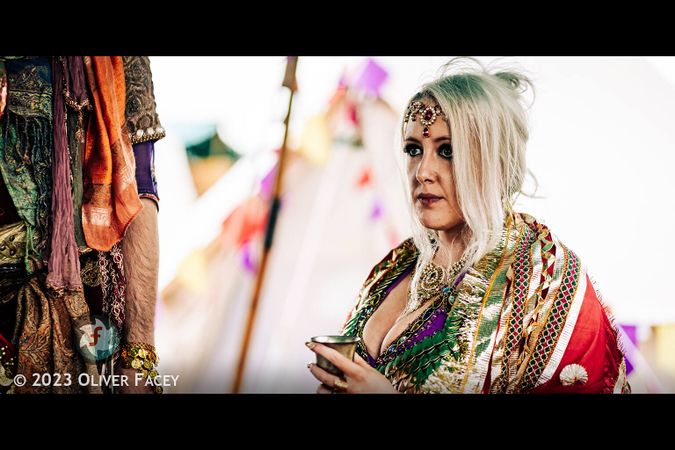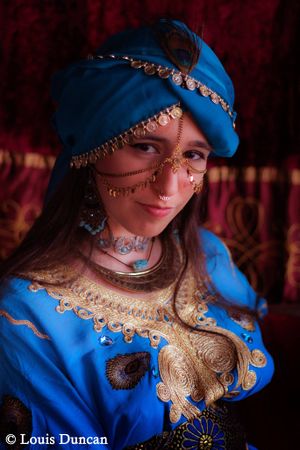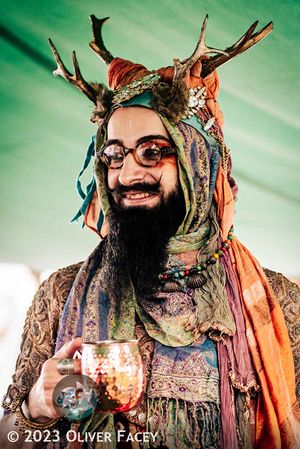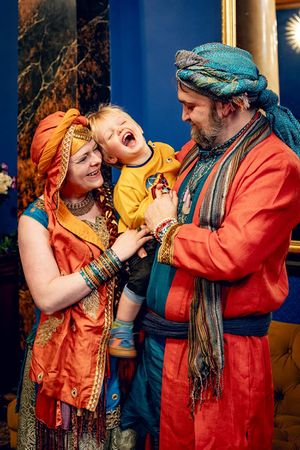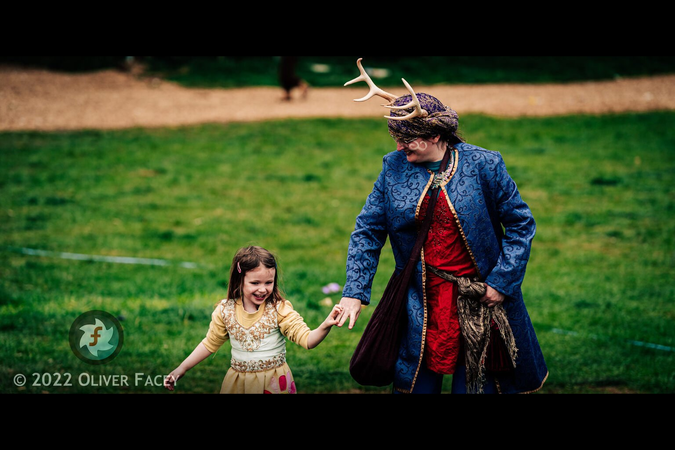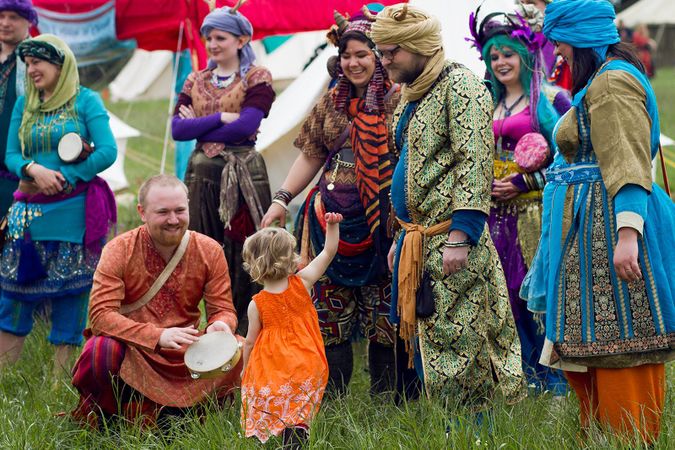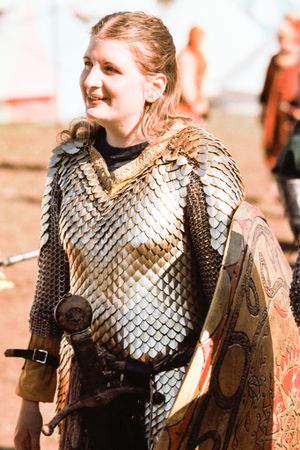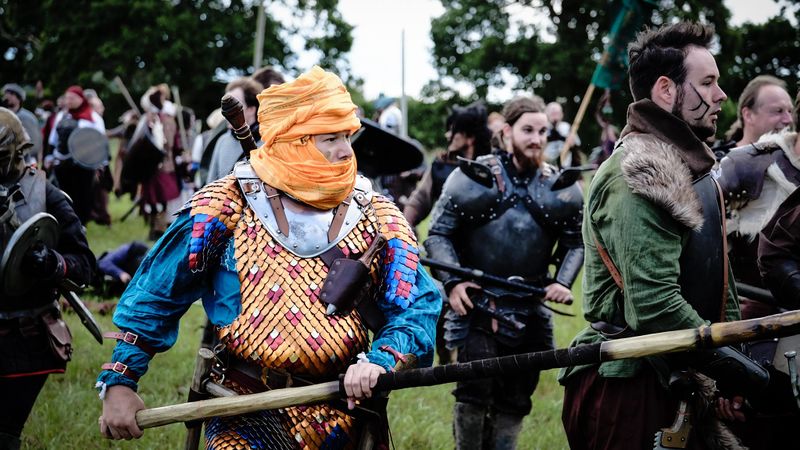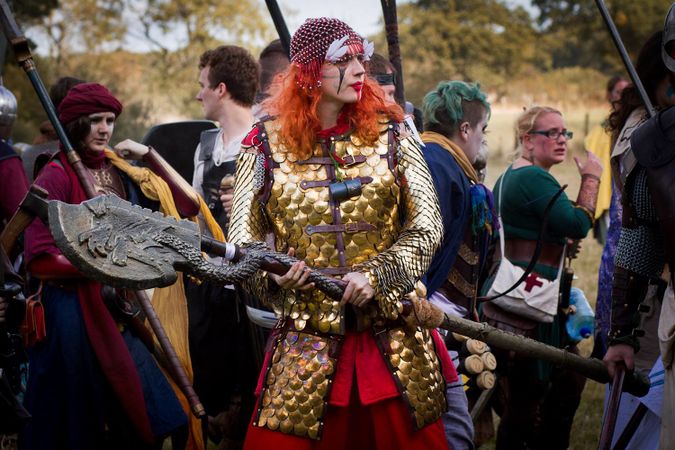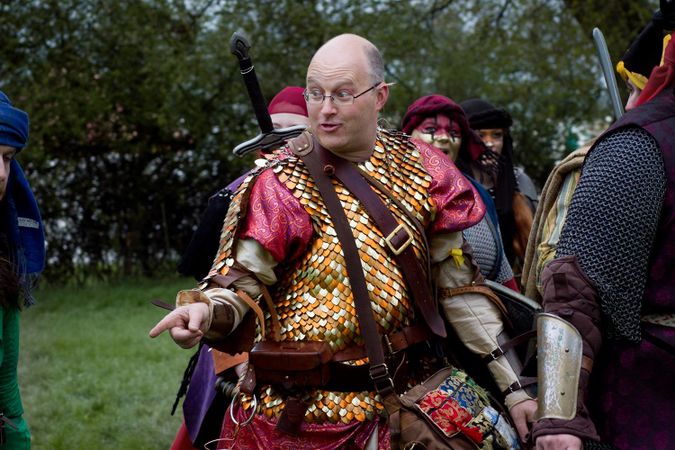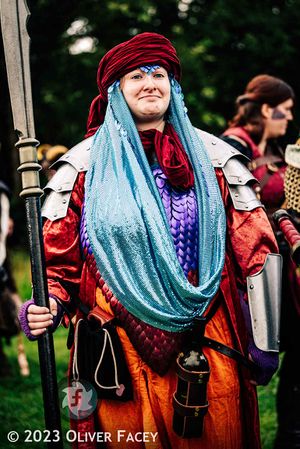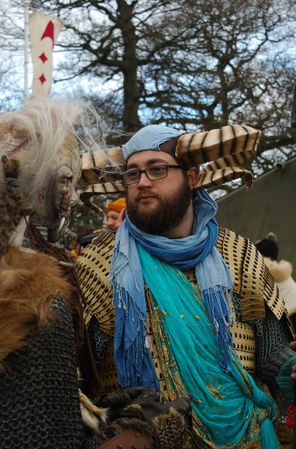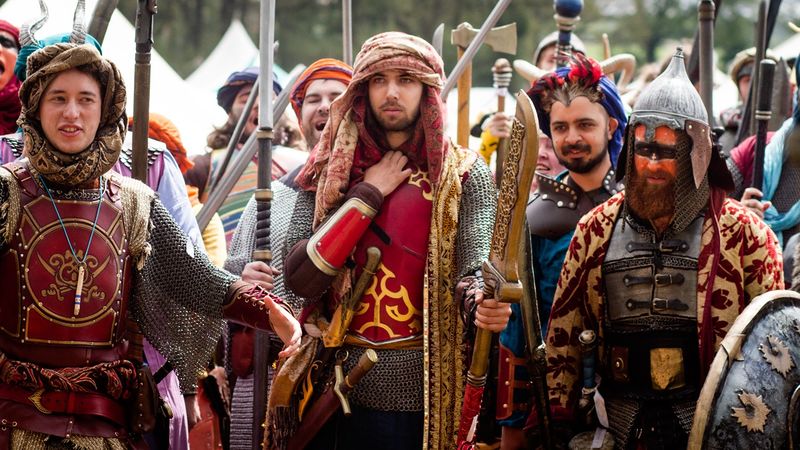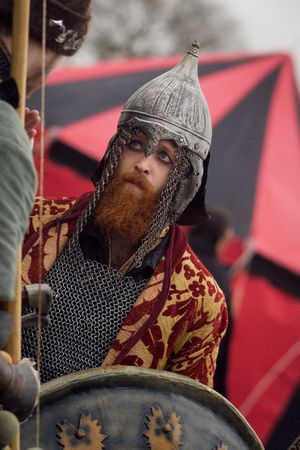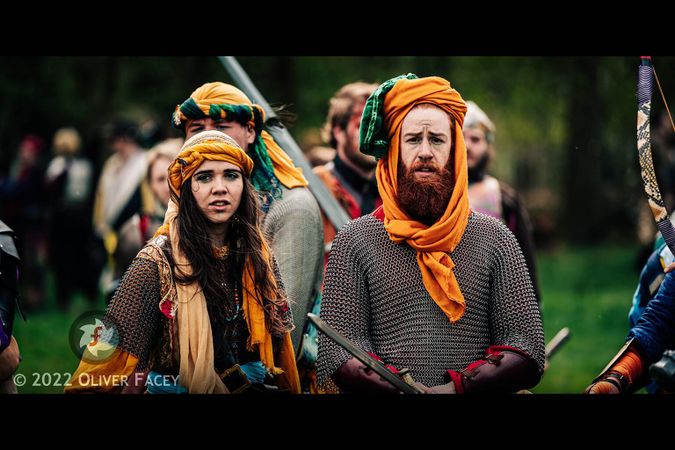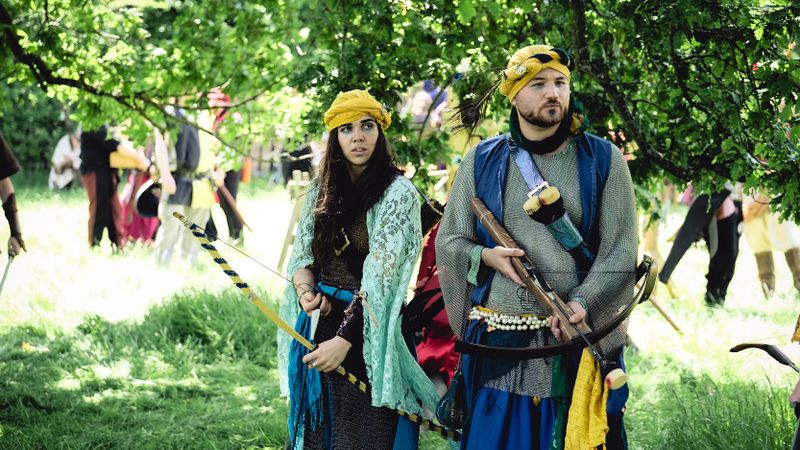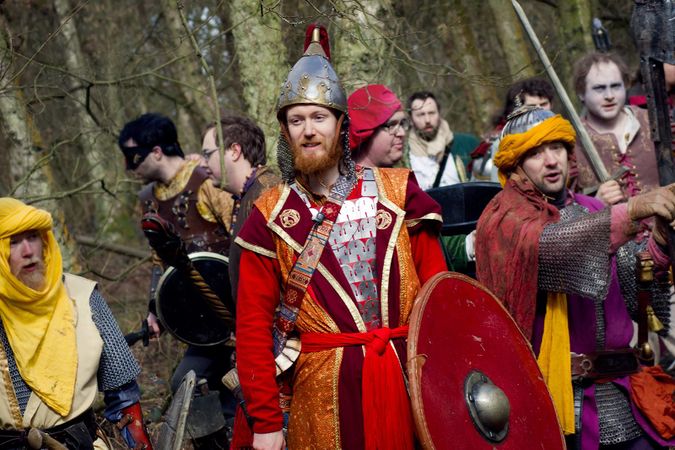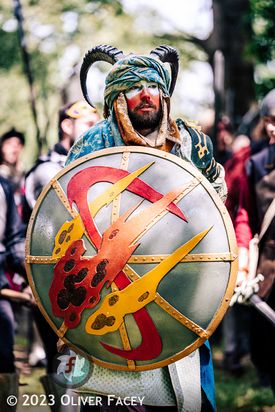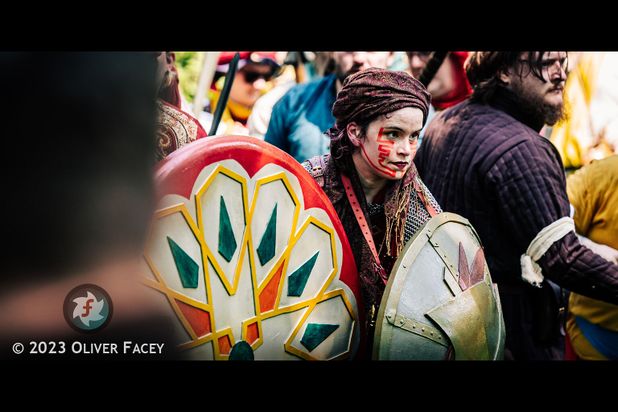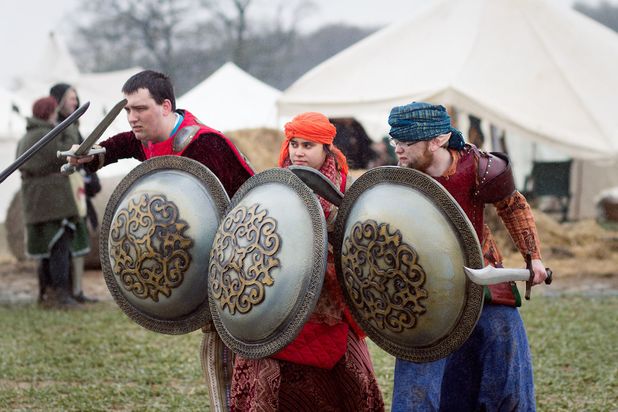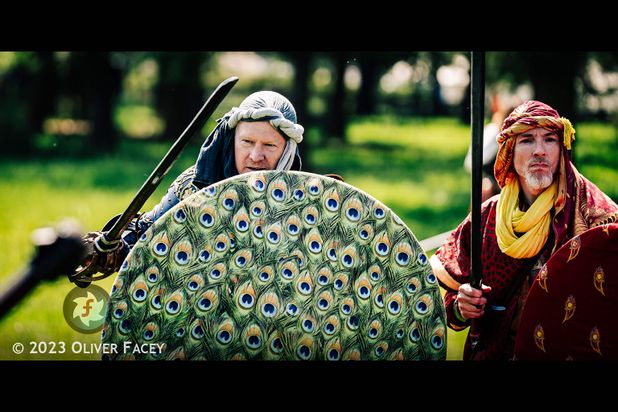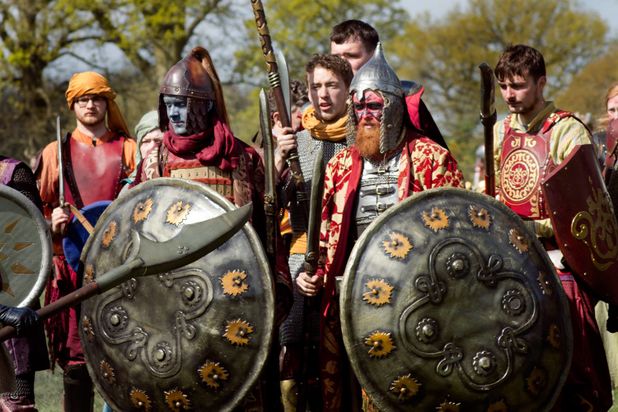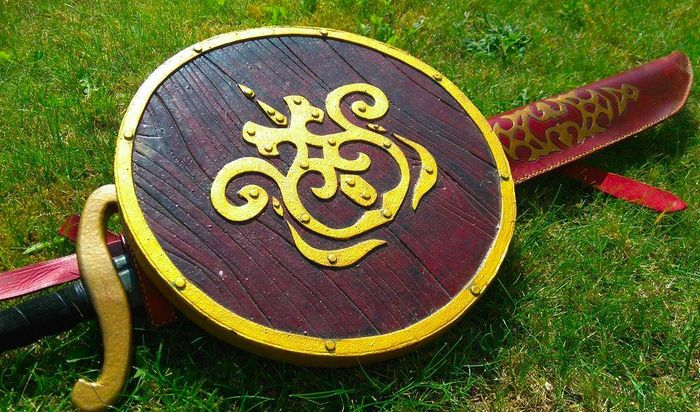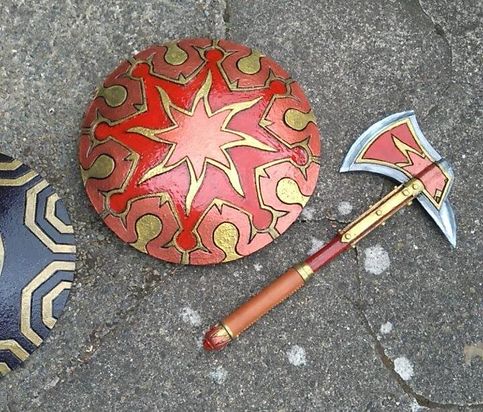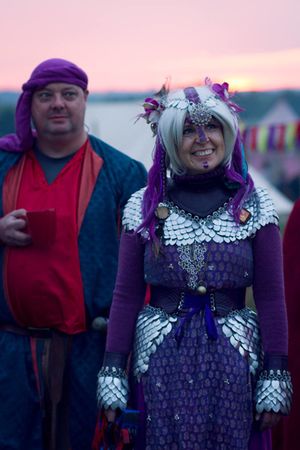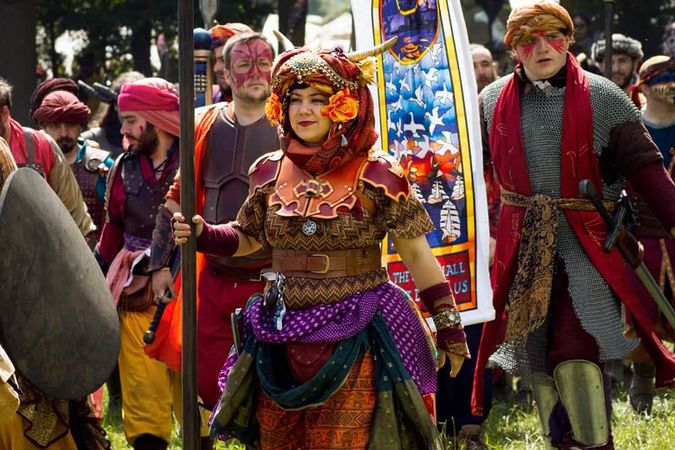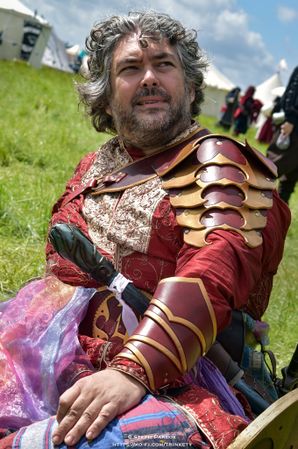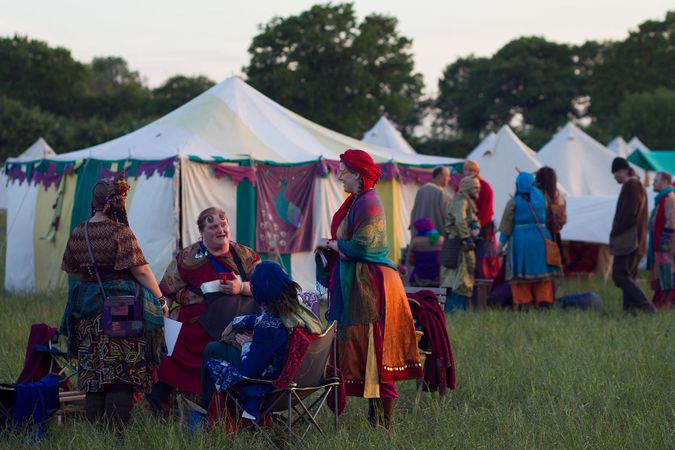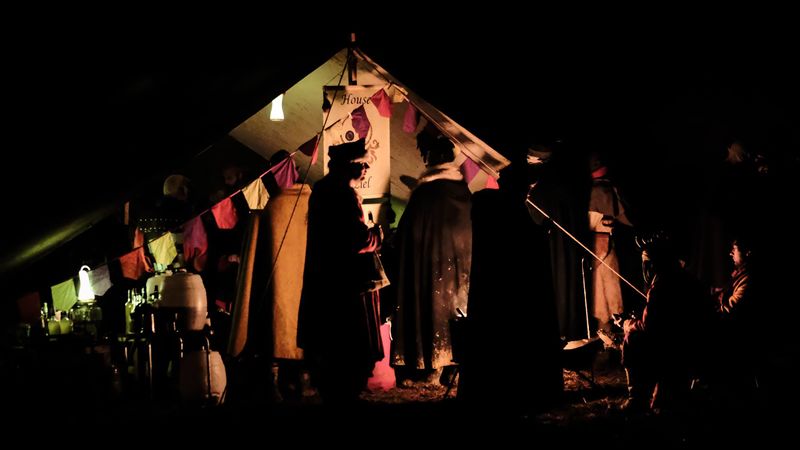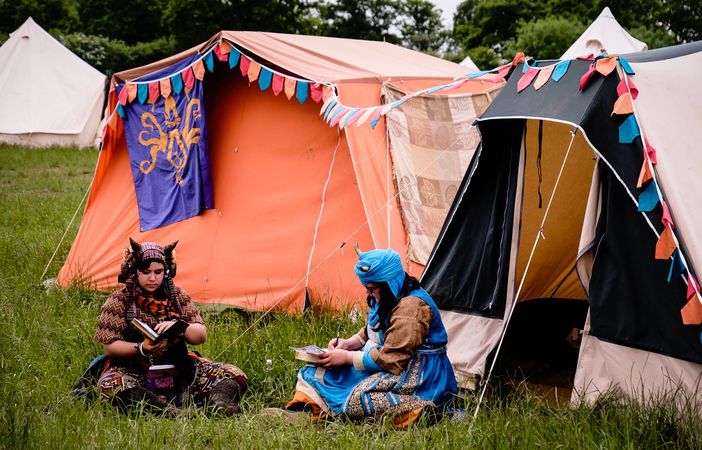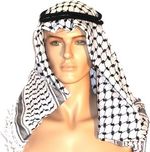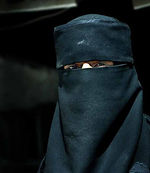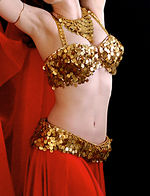The Brass Coast look and feel
Overview
Free, flowing, headstrong, sumptuous, practical, exuberant, hedonistic, colourful, rich, joyful.
The Freeborn look is one of bright colours, silks, jewels, and sumptuousness. They admire ornate or bejewelled items. To the Freeborn, a brilliant craftsman is one who can make something elegant as well as sturdy. Their weapons and armour are often engraved or adorned, but they are not fatuous and do not compromise utility for the sake of appearance. Jewellery is very common with the best pieces, like necklaces, crowns or tiaras, designed to frame the wearer's hands or face.
The image of the flame is central to the Freeborn culture; they believe it represents their spirit: wild, powerful and unchained.
Also see The Brass Coast costumes.
Breakdown
Influences
The traditional looks of Moorish Spain, Morocco, Algeria, Tunisia.
Colours
The Freeborn value bright, vibrant colours, especially the colours of flames: strong bright yellows, brilliant oranges and every conceivable shade of red as well as gold and silver. Peacock blue, Magenta and Turquoise often appear for contrast. Expensive clothing is made in brightly coloured layers to convey the impression of the fire within.
Black is considered severe and used for shrouds to wrap the dead. White is the colour of the poor, those too impoverished to afford exotic dyes.
Materials
Lightweight fabrics such as voiles and chiffons, either silk or synthetic. Also silks, brocades and other rich fabrics. Leather is considered unappealing for most clothing, it is a heavy material mainly reserved for boots and armour. Gold is prized over silver when available. When working in colder climes, such as at sea, a warmer layer of fleece or wool is worn as a base layer.
Gold, bronze and brass are much-prized, as are carved wooden objects (which are often imported, given the lack of wood on the Coast).
Weapons
Scimitars are less common than straight swords and axes which are the preferred weapons. The bhuj, a large heavy single-bladed spear, is the ideal polearm. The best quality weapons are intricately etched and engraved with complex designs. The hakima often have their rods, wands and staves made of finely carved wood. These featuring flame designs and are topped with red, orange or gold crystals.
Clothing
Veils, scarves, head-wraps, pantaloons, loose shirts and kaftans, are all part of Freeborn garb. Clothing is usually worn loose with layers of draped material slashed through to show a wealth of colour, and secured with sashes rather than belts. Outfits will often be decorated with shiny jewellery, bells, coins showing wealth in the glint of metal in the sun and the sound of metal as the wearer moves. Scabbards or pouches tend to hang at the waist by a silk cord that goes over the shoulder. Many Freeborn favour sandals as footwear, lacing up over the foot or higher up the leg, but slipper shoes are also common. Leather boots to mid-calf or the knee are favoured particularly on the battlefield.
Headscarves
The ideal headgear is the tagelmust (preferably in bright red, orange or yellow rather than blue).
Corsairs
Corsairs epitomise Freeborn daring and adventure. Javelins and bows are common but the Catazarri crossbow is also used. Many are lightly armoured decorated with flaming reds and oranges, but the boldest show off their success with ornately gilded plate. They may dress more simply than other Freeborn in trousers and tunic using Bright colours and patterned fabrics, but their flair for wealth tends to show through with jewellery worn at wrist and neck.
Kohan
As with any Freeborn, kohan usually dress as extravagantly as possible. What really sets them apart from other Brass Coast warriors however is their use of facepaint. Vivid colours are used, often in threatening designs, the better to unnerve their enemies. There is a wide variety of designs across the faces of the Coast, some kohan groups keeping their masks of war the same over decades of battle with others changing it day by day as their feelings take them.
A kohan band may cultivate a uniform look to their costume - generally through the use of colour. A given band is likely to pick one or two shades and encourage its members to wear clothing in these colours, leaving it up to the individual to determine the exact cut and style.
Some kohan take valuable trinkets from particularly impressive fallen enemies, generally pieces of jewelry. The more striking these items are, the more opportunities they give to tell stories about how they were acquired. .
Jewellery and Decoration
Jewellery is commonly used either as part of the clothes themselves or to frame the face or hands to draw attention to them. Veils are fashionable for those who wish to appear mysterious and alluring. Those who go tattooed tend to favour intricate henna-style designs.
Children
Children are an opportunity for parents to show off their wealth, dressing their offspring in traditional Freeborn styles.
Armour
Scale
Scale is the armour many Freeborn aspire to, ideally in a bright golden colour, worn like mail or else secured with leather. Where mail is worn, it is usually likewise a bright golden colour, or worn under or over a brightly coloured tunic.
Mail in the janissary style, particularly the chain helmets, is also commonly seen. Small pieces of plate or breastplates are popular especially if ornate and inlaid. Armour, whether metal or leather, usually has embellished edges and rich decoration, with calligraphy and ornate designs.
Shields
The Freeborn favour round (ideally domed) metal shields, highly decorated if possible. Gold inlay and engraving are both particularly popular.
Mage Armour
Freeborn battlemages favour mage armour that elicits the same themes as other armour; scales, brightly dyed leathers, and other materials in rich colours.
Camp
Less Appropriate
Whilst this look and feel page provides the ideal costume for the nation, it is important for players to familiarise themselves with the general costume rules for further guidelines, including those for inappropriate costume.
In defining the ideal look and feel for the Brass Coast we have chosen not to include some images. Some items were omitted so that the overall range of images avoids becoming too broad - we want each nation to look distinctive. Sometimes items were left out because the real world significance of them is so strong that it would impact the game, we want to avoid players confusing these nations with real world cultures. And some items are not part of the ideal because they come from a different historical period or are more modern in feel. It is common to see costume inspired by a range of historical periods but we wanted to be clear on what the ideal was. We've listed some of the items we chose not to include in the look and feel below along with a short explanation of why they are not perfect for the Brass Coast. It is okay to use these items as part of your kit, creating a costume is always a compromise as time and money are limited. What we want to do is be clear on the suggestions we are making, so that players who are looking to create new kit or add to their existing kit can be confident about what will look great for the nation.
Shemagh
Some of the costume inspiration for the Brass Coast comes from cultures with strong Arabic influences, but the main focus was Moorish Spain and North Africa. The shemagh or keffiyeh, the traditional headscarf that is white or patterned is more typical of the Middle East and more importantly it often looks very modern. We recommend the tagelmust as the ideal head covering for the Brass Coast.
Sartorial Hijab
There is no distinction between Freeborn of any gender. The traditional social attitudes towards modesty and women in Islamic societies are nothing to do with the Brass Coast emphasis on freedom and individuality. Because of this, and the strong real world associations, we chose to exclude most elements of sartorial hijab from the look and feel for the nation.
Belly dancing costumes
Although there are no particular modesty taboos, dancers tend to be far more interested in showing off how they can make fabrics flare and move than displaying their own flesh. Wild passionate dancing is a common Freeborn pursuit for people of any gender, but the perfect Freeborn costume features long flowing colourful garments. Roxanne's dance from the movie Alexander is a great inspiration for Freeborn dancing and costume.
Further Reading
Core Brief
Additional Information
